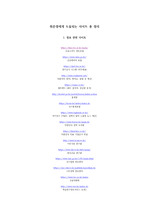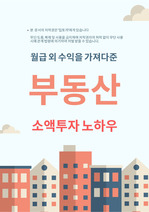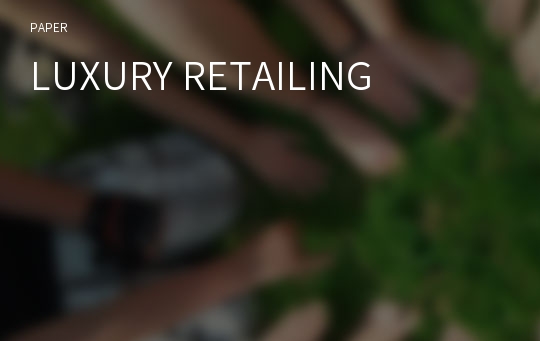* 본 문서는 배포용으로 복사 및 편집이 불가합니다.
서지정보
ㆍ발행기관 : 글로벌지식마케팅경영학회(GFMC)
ㆍ수록지정보 : Global Marketing Conference
ㆍ저자명 : Suzane Strehlau
ㆍ저자명 : Suzane Strehlau
영어 초록
The Brazilian luxury market has been rising since 2006, between 2010 and 2011 the growth rate was 33%. The stabilization of the currency, opening to imports and improving the population's purchasing power has given impetus to the growing demand for luxury brands that has grown steadily over the past 10 years with a rate of 10% per year. This growth is important indicator of the future of this market still represents only 0.7% of the demand for luxury items. (Brazil, 2010) Major luxury brands belonging to multinational corporations have already opened their own stores in Brazil. Some Brazilian luxury brands like H. Stern (jewelry) have operations in another countries. Other luxury companies are Fasano (hotel and food service), Osklen (fashion), Francesca Romana (jewelry) and Carmen Steffens (fashion). The company Trousseau focuses on homeware and differentiates the uniqueness of their products, enhancing the quality of fabrics and finishes. It has 21 stores and is present in São Paulo, Rio de Janeiro, Belo Horizonte, Brasilia and Salvador, and the virtual store (www.trousseau.com.br). The chocolate company Chocolat du Jour exists since 1987 underscores the high quality raw material and care in the preparation (http://www.chocolatdujour.com.br/) The “Les Lis Blanc” is a very expressive brand in this market, which has started with women wear and currently is a corporate group with the brands “Noir” (male wear), “Les Lis Blanc Beauté”, “John John” (casual wear), “Bobo” (fashion). Until the 1990s, some traditional luxury brands were operating in Brazil with a limited number of product lines and only through representatives. The decision to change the mode of operation in Brazil coincided with some factors of the national and global context. Locally, there was the opening of importation and stabilization of the economy, which until then had high inflation rates: between 1990 and 1994 the average rate of inflation was 764% a year (http://www.brasil.gov.br/sobre/ economic / financial market / inflation). In addition, there was an increase in the purchasing power of the population. In the external environment, the low rates of growth in the European market and the terrorist attacks that have diminished the flow of tourists in Europe and negatively affected the market at the beginning of the XXI century. The first flagship stores of international luxury brands in Brazil came to the city of São Paulo in the neighborhood of Jardins. The first street to get luxury brands was the Oscar Freire road (in São Paulo) and surroundings where these stores were concentrated in the first time. Even today, this region has a large number of stores of luxury brands. However, there was a migration of them to the shopping malls or malls - businesses closed as high street stores are considered less safe for the majority of the population. Nowadays the concentration of new luxury stores is in malls of the main capitals. In the state of São Paulo there is the “Shopping Iguatemi”, “Cidade Jardim”, “JK Iguatemi”. In Rio de Janeiro luxury points of sale are at “Fashion Mall”, “Shopping Leblon”, “Village Mall”. In Brasília (the capital) most important ones are “Iguatemi” and “Magrella”. The first Mall in Brazil was opened in 1966: "Iguatemi" in São Paulo. It was soon seen as the natural successor of the specialized street and the first to receive international luxury brands. It is part of a large business group called Jereissati, which one area of activity is called Premium malls, facing socioeconomic classes A and B. In 2012 the group released another shopping mall called JK Iguatemi (related to its location on Juscelino Kubitschek Avenue) although it calls itself Premium several luxury brands are present: Chanel, Bottega Veneta, Burberry, Carolina Herrera, Christian Louboutin, Chanel, Goyard, Longchamp, Miu Mil, Prada, Rimowa, Tod's, Tory Burch. Also in Sao Paulo in May 2008 another mall was opened “Shopping Cidade Jardim”, positioned as an upscale mall it is part of the venture group JHSF. The origin of the company is in construction sector and has other shopping centers in Brazil, but not using luxury concepts. The interior and exterior architecture can be seen in the design presenting natural lighting and gardens. The stores mix combines brands Louis Vuitton, Valentino, Red Valentino, Cartier, La Martina, Canali, Prada, Gucci the biggest of Latin America, Tag Heuer, Dior and Miu Miu, Fendi, Tod's and Repetto. These malls play an important role in the luxury market in Brazil. They are poles of attraction for international brands by offering an atmosphere consistent with their image and also pulling a large flow of consumers looking for a safer environment, greater convenience and glamour for their shopping. Before the emergence of these poles of luxury, the distribution of luxury goods in Brazil relied mostly on multi-brand stores, amongst which was the pioneer Daslu. Currently been supplanted by other projects of the same type as the Magrella Brasilia and NKStore. NK store is a clothing store that also has multi own brands (Talienk, Nk and Nkfitness) located in the Jardins neighborhood of São Paulo. Founded in 1997 by Natalie Klein daughter of a great Brazilian business, the shop features international brands: Stella Mccartney, Marc Jacobs, Marc By Marc Jacobs, Lanvin, Balmain, Givenchy, Issa, Alaïa, Catherine Malandrino, Malandrino, Blumarine, Celine, Pucci , Phillip Lim, Alexander Wang, Isabel Marant, Maison Michael, Aurélie Bidermann, Fiona Paxton and Moncler. Lim, Alexander Wang, Isabel Marant, Maison Michael, Aurélie Bidermann, Fiona Paxton e Moncler. There is one Brazilian Association of Luxury (ABRAEL), recently created. The aim is to gather participants operating in Brazil and to support the development of activities related luxury. (http://www.abrael.org.br/abrael.php). Audi, A | X Armani Exchange, Breitling, Cartier, Chanel, Estee Lauder, Gucci, Hugo Boss, Salvatore Ferragamo, Tiffany & Co. and Swarovski are associated and also Brazilian brands are present in the premium segments of fashion, homeware and services. Not all luxury brands are part of the Brazilian Association. Challenges Luxury companies established in Brazil have many challenges. The major challenge is to deal with the fluctuation of the exchange rate, the dollar trade is strongly linked to the situation in the Eurozone. (Cenarios FGV, 2013). Euros and Dollars can be freely purchased in exchange offices, banks or from individuals, the price depends on the market. Upper classes use to travel and make price and product comparisons, aware of product characteristics and prices levels outside the country these consumers need to fell advantages when purchasing in Brazil. Another challenge to be faced is the inefficiency of the infrastructure. The transport of cargo is mainly done by road transport. With dimension of 8,515,767.049 km ² (IBGE, Nov/2012) Brazil has only 96,353 km of paved roads (Portal Brazil, 2013). Ocean Ports are one bottleneck in international trade and the delivery of imported goods is undermined. Imported products must present legal wording on the packaging as the registration number of the legal entity (one number per company), and depending on their nature should get a registered number with the Ministry of Health or Agriculture. The complex taxation system is based on triggering events, such as the physical entry of a product in Brazil. There are taxes that belong to the federal government, others to the State or County. The Free-on-bord price (FOB) of the product might increase between 30 and 150% depending on the category and, moreover, the taxes overlap each other in what is called cascading effect. On average, there is a charge of 20% above FOB prices called Import Tax (II), 12% on the movement of goods and services (ICMS), 7% Tax industrialization of products, and other fees with lower tax rates, called by the acronyms COFINS PIS, PASEP. Besides the heavy tax structure and insufficient infrastructure, businessmen from luxury companies in Brazil complain about the difficulty in hiring skilled employees, especially to work in retail outlets. There is a lack of sellers with good training and general culture. Brazilian brands have an extra disadvantage comparing to foreign brands because Brazilian consumers tend to put more value on imported brands. This is rooted in the colonialist period, immigration and the prohibition of imports during the dictatorship. Luxury business in Brazil should continue to grow in coming years. The Brazilian consumer would increase his knowledge about luxury brands concepts and become more demanding and comparative in their consumption choices. Luxury retailing is expanding from the original points of sale which might affect the luxury perception of some brands.참고 자료
없음"Global Marketing Conference"의 다른 논문
 THE ROLES OF GREEN PACKAGING IN UGLY FOOD PURCHASE INTE..22페이지
THE ROLES OF GREEN PACKAGING IN UGLY FOOD PURCHASE INTE..22페이지 THE IMPACT OF INDUCED AWE ON ETHICAL TOURIST BEHAVIORS5페이지
THE IMPACT OF INDUCED AWE ON ETHICAL TOURIST BEHAVIORS5페이지 A BIBLIOMETRIC ANALYSIS OF SPIRITUAL TOURISM RESEARCH15페이지
A BIBLIOMETRIC ANALYSIS OF SPIRITUAL TOURISM RESEARCH15페이지 SOCIAL NETWORK ANALYSIS AND RESPONSE TIME TESTING: CONS..11페이지
SOCIAL NETWORK ANALYSIS AND RESPONSE TIME TESTING: CONS..11페이지 THE EFFECTS OF PARA-SOCIAL INTERACTION ON ONLINE CELEBR..3페이지
THE EFFECTS OF PARA-SOCIAL INTERACTION ON ONLINE CELEBR..3페이지 THE INFLUENCE OF OPINION LEADERS ON DAILY DEALS USER’S ..3페이지
THE INFLUENCE OF OPINION LEADERS ON DAILY DEALS USER’S ..3페이지 HOW IMMERSIVE RETAILING AFFECTS CONSUMERS’ URGE TO BUY:..6페이지
HOW IMMERSIVE RETAILING AFFECTS CONSUMERS’ URGE TO BUY:..6페이지 KEY TO SUPERSTARDOM IN A GLOBALISED MARKET: THE ROLE OF..6페이지
KEY TO SUPERSTARDOM IN A GLOBALISED MARKET: THE ROLE OF..6페이지 A POST-PANDEMIC LOOK AT TOURISTS’ PERCEIVED COOLNESS OF..4페이지
A POST-PANDEMIC LOOK AT TOURISTS’ PERCEIVED COOLNESS OF..4페이지 EXTRACTING OFFLINE RETAIL SHOPPING PATTERNS: OLLABORATI..5페이지
EXTRACTING OFFLINE RETAIL SHOPPING PATTERNS: OLLABORATI..5페이지

























